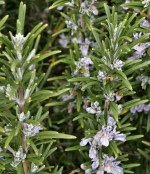 This evergreen shrub is native to the dry rocky hills of the Mediterranean area and is a member of the mint family, Lamiaceae, that also includes beebalm, basal, and lavender. Plants grow up to 6′ from a fibrous root system and have scaly bark and gray-green needle-like aromatic leaves 1/3 to 1.5″ long. The pale blue to white flowers are 1/2″ long, 2-lipped, and appear in clusters of 2 or 3 from late winter to early spring. Rosemary is hardy in zones 8-10 and like full sun and average, dry, well-drained soil that is neutral or slightly alkaline. Reproduction is by cuttings, layering, or seed but since germination rates are very low and offspring from seed tend to be inferior, vegetative propagation is preferred. The genus name, Rosmarinus, comes from the Latin words ros meaning dew, and marinus meaning pertaining to the sea and may refer for the plants ability to thrive in coastal areas. The specific epithet, officinalis, indicates that the plant has medicinal qualities.
This evergreen shrub is native to the dry rocky hills of the Mediterranean area and is a member of the mint family, Lamiaceae, that also includes beebalm, basal, and lavender. Plants grow up to 6′ from a fibrous root system and have scaly bark and gray-green needle-like aromatic leaves 1/3 to 1.5″ long. The pale blue to white flowers are 1/2″ long, 2-lipped, and appear in clusters of 2 or 3 from late winter to early spring. Rosemary is hardy in zones 8-10 and like full sun and average, dry, well-drained soil that is neutral or slightly alkaline. Reproduction is by cuttings, layering, or seed but since germination rates are very low and offspring from seed tend to be inferior, vegetative propagation is preferred. The genus name, Rosmarinus, comes from the Latin words ros meaning dew, and marinus meaning pertaining to the sea and may refer for the plants ability to thrive in coastal areas. The specific epithet, officinalis, indicates that the plant has medicinal qualities.
Rosemary has been associated with memory since ancient times when Greek students wore the herb in their hair while studying. Shakespeare’s Ophelia speaks of rosemary and remembrance just before she dies, and Thomas More considered it “sacred to remembrance, and therefore to friendship.” Brides have included the herb in their wreaths and bouquets up into modern times while mourners have placed a sprig of rosemary in graves to indicate they will not forget the deceased. On the other hand, rosemary was used during the Middle Ages to ward of nightmares and demons but by Renaissance times the value of rosemary as a medicinal herb was recognized and it was used to treat everything from paralysis of the joints to depression. Over the years rosemary has also been used as a moth repellent, topiary plant, and culinary herb.